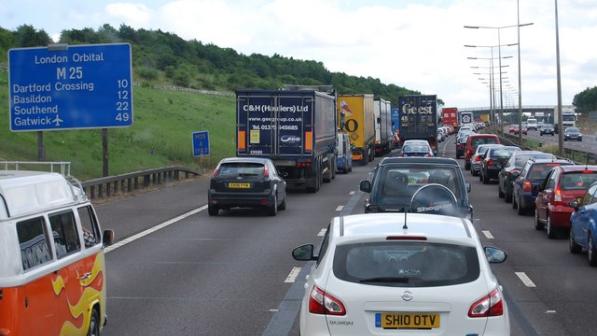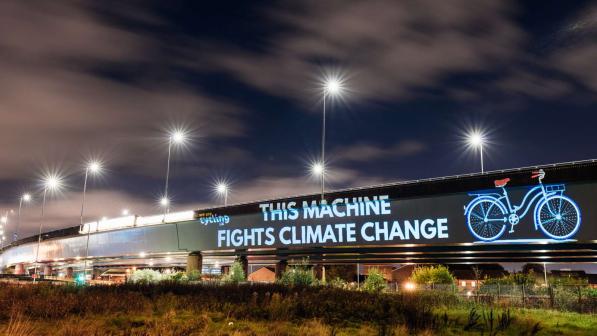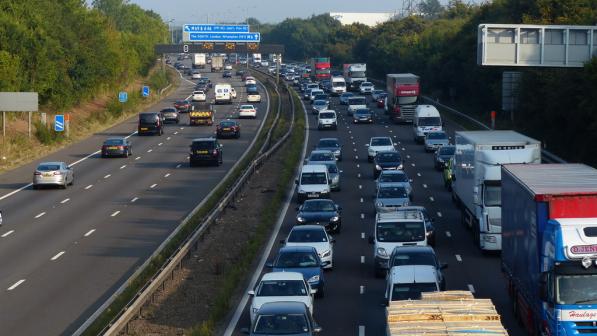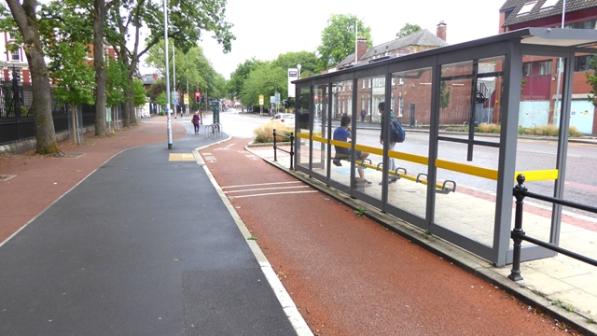The Government still isn't on course to meet its 2025 cycling targets. So what now?

The last few weeks have seen a flurry of activity, in the run-up to the COP26 international climate summit which the UK Government is hosting in Glasgow. Cycling UK and our allies have put a huge effort into securing increased funding and policy backing for action to halt and reverse the growth of road traffic, and to invest in healthy and sustainable transport alternatives.
The Government's Transport Decarbonisation Plan, its 'Net Zero' Strategy and its Budget and Spending Review have come and gone in quick succession. There have been plenty of fine words, not just on cycling and walking, but also on many other aspects of sustainability.
Yet the Chancellor's Spending Review, announced yesterday, 27 October 2021, has left sustainable transport campaigners and other environmental groups bitterly disappointed.
From Cycling UK's perspective, there is no new funding for cycling and walking. Therefore, on the face of it, the Department for Transport (DfT) is still not on course to meet its cycling and walking targets for 2025.
So it's now time to take stock, look at what these documents all say, and reflect on what needs to happen now if the cycling and walking targets are to be met, despite this frustrating lack of support from the Chancellor.
The Transport Decarbonisation Plan and Net Zero Review
The Transport Decarbonisation Plan (TDP), published in September, contained a lot of fine words - including a restatement of the admirable aims of the Government's excellent 'Gear Change' vision document for cycling and walking. In particular, it included a commitment to deliver "a world class cycling and walking network for England by 2040", and quite a lot of other positive ideas which are discussed in my previous round-up of its strengths and weaknesses.
However, its biggest weakness was its indecisiveness on whether the aim was actually to reduce road traffic, or simply to replace our petrol and diesel vehicles with electric vehicles (EVs). This is despite overwhelming evidence (with more to come shortly!) that relying on EVs cannot sufficiently decarbonise transport for the Government to meet its own 'net zero' target by 2050. It would, of course, also fail to tackle the problems of congestion, particulate pollution (particularly from tyre dust), road danger, physical inactivity, and the many social inequalities which result from excessive car-dependence.
The 'Net Zero' Strategy contained a very concise summary of the 'Gear Change' vision. It also included one bit of new news from a cycling and walking perspective.
The 'Gear Change' document had contained a target to increase the proportion of trips in towns and cities made by walking and cycling, to 50% by 2030. Unfortunately, the Government couldn't tell us how this would even be measured, let alone what the current level was. So we didn't take much notice of this target (as I explained towards the end of my 'message to ministers' blog).
However, p326 of the 'Net Zero' Strategy tells us that the Government now estimates that the current level is 42%, and that they plan to increase this:
- To 46% by 2025;
- To 50% by 2030 (as previously announced); and
- To 55% by 2035.
The 'Net Zero' Strategy also mentions the old target (which was originally set in the Government's first Cycling and Walking Investment Strategy, CWIS1), to double the number of trips made wholly or in part by cycling, from 2013 levels, by 2025.
However, Cycling UK has repeatedly highlighted that the Government is sitting on research which it commissioned - but has refused to publish (despite several earlier promises to do so: 17 Jan 2020, 30 Jan 2020, 20 May 2020) - which apparently suggests that meeting this target would require investment of £6-8bn between 2020 and 2025.
Other environmental groups had pointed to similar mismatches between the 'Net Zero' Strategy's lofty ambitious and targets, and the lack of policies and funding to deliver them. Chris Stark, the Chief Executive of the Committee on Climate Change (the Government's statutory advisor on meeting its 'net zero' targets under the Climate Change Act), immediately noted the Net Zero Strategy's table of "deployment assumptions" (including the cycling and walking targets), and tweeted that the CCC would be monitoring progress carefully!
Unfortunately, the failure of the Spending Review to deliver the funding needed to fulfil the 'Net Zero' vision, three days before the COP26 climate summit, has seriously weakened the Prime Minister's aspirations to show "global leadership" when he travels to Glasgow next week. There has been particular anger at the continued freezing of fuel duty. This has already caused huge increases in traffic and in climate and pollutant emissions, as well as reductions in revenue to rail companies and to the Treasury. It also undermines efforts to encourage more walking and cycling to replace unnecessary car trips.
Cycling and walking investment: understanding the numbers
The Chancellor's failure to back active travel also leaves DfT's admirable cycling and walking team with the unenviable task of creating a second Cycling and Walking Investment Strategy (CWIS2), with insufficient ringfenced funding to meet their targets. However, it is by no means a hopeless task.
The previous Cycling and Walking Investment Strategy (CWIS1) contained less than 1/6th of the amount of ringfenced funding for cycling and walking, i.e. just £314m for the five-year period up to 2020/1. Yet the DfT team did a superb job of enabling councils to secure additional funding for cycling and walking, from non-ringfenced sources, such as the Transforming Cities Fund, the Housing Infrastructure Fund and the Future High Streets Fund, as well as from Local Transport Plan funding and Local Growth Funds. In the end, they estimated that total investment in cycling and walking over this period was around £2.4bn.
They will now need to do perform the same trick yet again, if they are to magic £2bn of ringfenced funding into £6-8bn of total funding up to 2024/5.
However, the downside of non-ringfenced funding is that local authorities can't rely on it. This lack of certainty deters them from making ambitious plans for extensive cycling and walking networks, for fear of raising expectations among their local electorates that they then can't fulfil.
Yet making ambitions plans - taking that risk - is exactly what they need to do, so that they can take advantage of any non-ringfenced funding that comes along. I'll return to this in a moment.
But first, let's have a quick look at the numbers. As I understand it, the £2bn consists of:
- £588m that has already been spent or allocated - £250m in 2020/1 and £388m in 2021/2.
- Around £600m that has gone towards topping up a previously announced City Regions Sustainable Transport Settlements funding pot. This was originally due to be £4.2bn, to be spent over the next 3 years, by 8 English city regions (Greater Manchester, the Liverpool City Region, the West Midlands, West of England, West Yorkshire, South Yorkshire and Tees Valley - n.b. the North East seems to have missed out, and London receives a separate funding settlement). That fund has now been topped up to £5.7bn. DfT officials are confident that their £600m contribution will yield more than £600m of cycling and walking investment - in which case, they will already have secured some non-ringfenced funding for cycling and walking.
- Another £710m will now become available for cycling and walking investment in other parts of England over the next 3 years. The Government says this fund will "build hundreds of miles of high quality, segregated cycle lanes, provide cycle training for every child and deliver an e-bike support programme to make cycling more accessible".
- That leaves about £100m still to be allocated, through the process of preparing the second Cycling and Walking Investment Strategy (CWIS2). Cycling UK looks forward to a constructive dialogue with DfT officials on how best to spend this, reflecting our submissions to last year's and this year's Spending Reviews (n.b. last year's planned multi-year Spending Review eventually got cancelled and turned into just a 1-year budget, due to a combination of Brexit-related and coronavirus-related funding uncertainties). See also our submission to a recent parliamentary inquiry on funding for cycling and walking (the MPs were very supportive!), and a summary briefing for MPs.
So what now?
Let me conclude with 10 things that now need to happen, for the Government to meet its cycling and walking targets for 2025 (not to mention those mysterious targets for 2030 and beyond!):
- The Department for Transport (DfT) needs to continue its admirable track-record of securing non-ringfenced funding for cycling and walking. As explained above, they have done it before, and we must hope they can do it again. Given their track record, it's not impossible that they might actually reach £6-8bn of total funding, starting from a ring-fenced pot of £2bn.
- Local authorities need to be ready to take advantage of any non-ringfenced funding opportunities that may arise. That means being ambitious, not cautious, in developing their Local Cycling and Walking Infrastructure Plans (LCWIPs), i.e. their plans for comprehensive cycling and walking networks in their areas. Councillors need to show some political bravery in making plans, accepting the risk that funding might not come along to fulfil those plans, if they are to have plans to take advantage of any funding that does come along! To this end, Cycling UK is working alongside our partners at Sustrans and Living Streets, to help councils develop these plans, as part of a DfT funded LCWIP support project. Supporting councils to develop ambitious network plans will also help them (and us!) to convince the Treasury that councils really can spend significant sums of money on cycling and walking, if this is made available - the Treasury's lack of confidence in councils' ability to spend the money was a real sticking point ahead of this year's Spending Review. We want to avoid a repeat of this situation when the Treasury launches its next Spending Review, in about 2.5 years' time.
- This level of ambition needs to spread from cities to rural areas. When the ringfenced funding available for cycling and walking was just £314m, it is unsurprising that rural counties got left out, and were left feeling that cycling was only really relevant for cities like Greater London and Greater Manchester. But with £2bn on the table and the prospect of more to come, our message to shire county councils is: "Think again!" Unlike the situation in large cities, most of the car traffic in a smaller town isn't just travelling within that town. So the main deterrent to getting people out of cars and onto bikes isn't the lack of cycle-friendliness of the urban streets: it's the terrors of the 60mph single-carriageway connecting those towns to other nearby towns and villages. So we need to ensure that the Spending Reviews' £2.6bn allocation for local A-road improvements also delivers improved cycling conditions on exactly this type of road.
- DfT's seccond Cycling and Walking Investment Strategy (CWIS2), due out next Spring, must spell out clearly how both ring-fenced and non-ringfenced money will be allocated. The majority of the £2bn needs to go towards enabling councils to implement their cycling and walking infrastructure plans. Further money needs to go towards: providing cycling and walking links along and across major road corridors and the HS2 scheme; cycle-rail improvements; public hire-bike schemes (especially in more disadvantaged areas); cycle training for people of all ages and abilities; initiatives to promote cycling in schools, workplaces and community groups (such as Cycling UK's Big Bike Revival, Community Cycle Clubs and Cycling for Health projects); and supporting the uptake of electric bicycles (including cargo bikes and non-standard cycles). This last point is particularly important for groups such as health patients and people with disabilities who have most to gain from them, but who are most likely to think that "cycling isn't for someone like me" unless given a supportive opportunity to 'try before they buy'.
- DfT needs to commission and publish research on the policies and funding needed to meet its targets to increase cycling and walking to 50% of all trips in towns and cities by 2030 - and to 55% by 2035. Here too, we need to avoid a repeat of the situation where DfT knew what was needed, but was unable to publish it, limiting the ability of Cycling UK and others to campaign for it.
- The proposed new body Active Travel England needs to be set up quickly, with the powers, resources and independence it needs to do its job well. The 'Gear Change' vision document promised that Active Travel England would play a major role in both requiring and supporting local authorities to consistently apply the Government's new Cycling Infrastructure Design standards (Local Transport Note LTN 1/20), not just when developing schemes specifically aimed at enabling walking and cycling, but in everything they do, including new road and traffic schemes, planned highway maintenance work and new developments. The sooner Active Travel England is established, and the stronger it is, the better the chances of DfT meeting its cycling and walking targets, both for 2025 and for 2030 and beyond.
- New Communities Secretary Michael Gove's forthcoming planning reforms need to ensure that new housing and other developments are designed and located in ways that support cycling, walking and public transport, while reducing car-dependence. They will need to be very different from the much-criticised reforms proposed by his predecessor.
- The Department for Environment, Farming and Rural Affairs (DEFRA) needs to engage with the issue of opening up off-road access for cycling and walking. During Michael Gove's previous stint as Environment Secretary, he promised to reform post-Brexit agricultural subsidies to ensure that public funding would deliver public goods, such as increased public access to the countryside. Yet since his departure, DEFRA has gone completely silent on this subject, despite the pandemic showing just how important access to the outdoors is for the nation's health, with the Environment Agency saying that this could save billions of pounds annually in NHS costs. It's also a way of enabling people to use the rights of way network to make day-to-day journeys by cycling and walking, e.g. allowing children in villages to walk or cycle to schools in nearby towns, as well as allowing families in those towns to get out into the countryside at the weekend without having to drive.
- The Department for Health also needs to back cycling and walking, particularly DfT's plans for a 'cycling on prescription' scheme. Linked with the Government's promised subsidy package for electric pedal cycles, this could be a game-changer in boosting not just the numbers of people cycling, but the diversity of those who cycle, overcoming the barrier that so many people feel that "cycling isn't for someone like me".
- Crucially, the DfT needs to recognise that increased cycling and walking, and reductions in road traffic, go hand in hand. Investment in cycling and walking is essential if we are to reduce road traffic (and its many adverse impacts on our health, our economy, our communities and our environment). But the opposite is also true: a willingness to reduce road traffic is essential for maximising the benefits of cycling. If the Government continues to invest in roads and freeze fuel duty, instead of implementing road pricing or similar traffic restraint measures, it is undermining its chances not just of reaching its cycling and walking targets, but also its 'net zero' targets. It is therefore fundamental to the Government's ambitions to show "global leadership" in tackling the climate crisis - not to mention the congestion crisis, the pollution crisis and the inactivity-related health crisis.
In short, maximising the benefits of cycling requires real political leadership, from central Government as well as from local authorities.
'Leadership': comparisons with our neighbours
The Welsh Government is investing £75m this year in cycling and walking, amounting to £23.66 per person annually. It has excellent planning policies and has set a target to increase the proportion of trips made by cycling, walking and public transport, from 32% in 2019 to 45% in 2040.
The Scottish Government is investing £155m this year (amounting to £21 per person annually), but has recently promised to raise this to £320m in 2024/5. That amounts to 10% of total transport spending or £58.50 annually. It too has excellent planning policies, and a target to reduce the distance travelled by cars in Scotland by 20% by 2030.
By contrast, the £2bn allocated for cycling and walking in England amounts to £8.42 per person annually. England has lousy planning policies and no target to reduce either the amount of mileage or the proportion of trips made by car.
Yet, as noted earlier, the DfT has set the admirable ambition to have "A world class cycling and walking network for England by 2040". So what might that mean?
Well, the Dutch have a 35,000km network of protected cycle lanes, amounting to almost exactly a quarter of the length of the Dutch road network. The equivalent for England would mean a network of around 76,000km (47,000 miles) of protected cycle lanes. My 'back of a cigarette-packet' estimate (based on these DfT-published figures) is that this will require investment of around £36bn, or an average of about £2bn per year (i.e. not just £2bn over 5 years), between now and 2040.
I've previously quoted the Government's promise that its £2bn of funding will provide "hundreds of miles of protected cycle lanes". But developing "a world class cycling network" will clearly require tens of thousands of miles. And that's going to require a lot more funding.
But here's the other side of that coin. Reaching Dutch levels of cycle use could deliver nearly £1/4 trillion worth of benefits by 2050. That would be nicely in line with Government estimates that cycling and walking investment delivers at least £5 of benefits for every £1 invested, representing "very high" value for money.
So it's worth remembering that £2bn is 6 times more than the amount available for cycling and walking as recently as 2017. It's 80 times more than the one-year allocation of £5m that was made available in 2005, when the Government first set a national cycling budget.
In short: we've made a lot of progress - and investment in cycling and walking in England is at last moving towards to the right ballpark, creating opportunities that local councils now need to seize. But we also still have long, long way to go!




